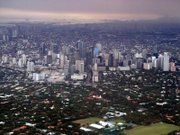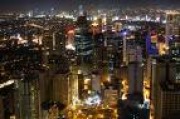LOCATION
 Manila lies at the mouth of the Pasig River on the eastern shores of Manila Bay, which is on the western side of Luzon. It lies about 950 kilometers southeast of Hong Kong and 2,400 kilometers northeast of Singapore. The river bisects the city in the middle. Almost all of the city sits on top of centuries of prehistoric alluvial deposits built by the waters of the Pasig River and on some land reclaimed from Manila Bay. The layout of the city was haphazardly planned during Spanish Era as a set of communities surrounding the original Spanish Era walled city of Manila, called Intramuros. Intramuros is one of the oldest walled cities in the far east. During the American Period, some semblance of city planning using the architectural designs and master plans by Daniel Burnham was done on the portions of the city south of the Pasig River. Burnham, the noted American city planner and architect, was famed for his plans and designs of Chicago, Cleveland (the Group Plan), San Francisco, Washington, DC (the McMillan Plan), and Baguio City, details of which appear in The Chicago Plan publication of 1909.
Manila lies at the mouth of the Pasig River on the eastern shores of Manila Bay, which is on the western side of Luzon. It lies about 950 kilometers southeast of Hong Kong and 2,400 kilometers northeast of Singapore. The river bisects the city in the middle. Almost all of the city sits on top of centuries of prehistoric alluvial deposits built by the waters of the Pasig River and on some land reclaimed from Manila Bay. The layout of the city was haphazardly planned during Spanish Era as a set of communities surrounding the original Spanish Era walled city of Manila, called Intramuros. Intramuros is one of the oldest walled cities in the far east. During the American Period, some semblance of city planning using the architectural designs and master plans by Daniel Burnham was done on the portions of the city south of the Pasig River. Burnham, the noted American city planner and architect, was famed for his plans and designs of Chicago, Cleveland (the Group Plan), San Francisco, Washington, DC (the McMillan Plan), and Baguio City, details of which appear in The Chicago Plan publication of 1909.
Manila is bordered by several municipalities and cities in Metro Manila: Navotas and Caloocan City to the north, Quezon City to the northeast, San Juan and Mandaluyong City to the east, Makati City to the southeast, and Pasay City to the south.COMMERCE
 Every district in the city with the exception of Port Area has its own public market, locally called the pamilihang bayan or Palengke. Public markets are often divided into two, the dry goods section and the wet goods section. Commerce in these public markets is lively, especially in the early morning. Under the urban renewal program of the incumbent administration, some of the public markets had been refurbished and given a fresher look, like the Sta. Ana public market.
Every district in the city with the exception of Port Area has its own public market, locally called the pamilihang bayan or Palengke. Public markets are often divided into two, the dry goods section and the wet goods section. Commerce in these public markets is lively, especially in the early morning. Under the urban renewal program of the incumbent administration, some of the public markets had been refurbished and given a fresher look, like the Sta. Ana public market.
Modern shopping malls dot the city especially in the areas of Malate and Ermita. SM City Manila, part of the country's largest chain of malls, stands behind the Manila City Hall, while the original SM Department store still operates in Carriedo in Sta. Cruz while another called SM Centrepoint is located north east of the city in Sta. Mesa close to the Quezon City-San Juan boundary. One of the popular malls that lies at the heart of Manila is Robinson's Place Ermita. In the southern part of the city in Malate district is Harrison Plaza, one of the city's oldest shopping malls.TRANSPORTATION
 Air
Air
Ninoy Aquino International Airport (NAIA), eight kilometres south of the city centre, serves Manila, the Metro Manila area and the nearby provinces. Over 40 airlines provide daily service to over 26 cities and 19 countries worldwide. Approximately 17 million travellers use NAIA a year, straining what was originally a domestic airport built in the 1930s. A second terminal, Terminal 2 (or the Centennial Terminal) opened in October 1999. The International flag-carrier Philippine Airlines now uses this terminal exclusively for both its domestic and international service while all other international flights use the original NAIA terminal. Air Philippines is in the transition to the newer Terminal 2 alongside PAL.
Rail Transport
Manila is the hub of a railway system on Luzon. The main terminal of the Philippine National Railways is in the Tondo district. Railways extend from this terminal north to the city of San Fernando in Pampanga and south to Legazpi City in Albay, though only the southern railway is currently in operation.
Manila is also serviced by the Manila Light Rail Transit System (separate from Manila Metro Rail Transit System), a national priority project designed to address the overwhelming traffic that congests the national capital. Development of the system began with its inception in the 1970s under the Marcos administration, making it the first light rail transport in Southeast Asia.
Seaports and Piers
The City of Manila is the chief seaport of the Philippines. North Harbor and South Harbor experience busy periods during long holidays such as Holy Week, All Saints Day and the Christmas holidays. The Port of Manila serves the city's commercial needs, it also one of South East Asia's more major ports.
Manila is bordered by several municipalities and cities in Metro Manila: Navotas and Caloocan City to the north, Quezon City to the northeast, San Juan and Mandaluyong City to the east, Makati City to the southeast, and Pasay City to the south.
Modern shopping malls dot the city especially in the areas of Malate and Ermita. SM City Manila, part of the country's largest chain of malls, stands behind the Manila City Hall, while the original SM Department store still operates in Carriedo in Sta. Cruz while another called SM Centrepoint is located north east of the city in Sta. Mesa close to the Quezon City-San Juan boundary. One of the popular malls that lies at the heart of Manila is Robinson's Place Ermita. In the southern part of the city in Malate district is Harrison Plaza, one of the city's oldest shopping malls.
Ninoy Aquino International Airport (NAIA), eight kilometres south of the city centre, serves Manila, the Metro Manila area and the nearby provinces. Over 40 airlines provide daily service to over 26 cities and 19 countries worldwide. Approximately 17 million travellers use NAIA a year, straining what was originally a domestic airport built in the 1930s. A second terminal, Terminal 2 (or the Centennial Terminal) opened in October 1999. The International flag-carrier Philippine Airlines now uses this terminal exclusively for both its domestic and international service while all other international flights use the original NAIA terminal. Air Philippines is in the transition to the newer Terminal 2 alongside PAL.
Rail Transport
Manila is the hub of a railway system on Luzon. The main terminal of the Philippine National Railways is in the Tondo district. Railways extend from this terminal north to the city of San Fernando in Pampanga and south to Legazpi City in Albay, though only the southern railway is currently in operation.
Manila is also serviced by the Manila Light Rail Transit System (separate from Manila Metro Rail Transit System), a national priority project designed to address the overwhelming traffic that congests the national capital. Development of the system began with its inception in the 1970s under the Marcos administration, making it the first light rail transport in Southeast Asia.
Seaports and Piers
The City of Manila is the chief seaport of the Philippines. North Harbor and South Harbor experience busy periods during long holidays such as Holy Week, All Saints Day and the Christmas holidays. The Port of Manila serves the city's commercial needs, it also one of South East Asia's more major ports.
No comments:
Post a Comment